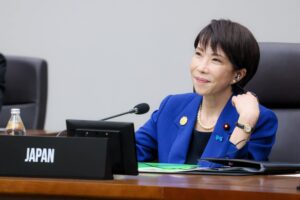Tokyo Report | Politics | East Asia
Since taking office, Takaichi has shown a willingness to moderate on many issues – with the marked exception of national security policy.

Japanese Prime Minister Takaichi Sanae attends the APEC Economic Leaders’ Meeting in Gyeongju, South Korea, Oct. 31, 2025.
Credit: [Prime Minister’s Office of Japan](https://www.facebook.com/photo.php?fbid=1…
Tokyo Report | Politics | East Asia
Since taking office, Takaichi has shown a willingness to moderate on many issues – with the marked exception of national security policy.

Japanese Prime Minister Takaichi Sanae attends the APEC Economic Leaders’ Meeting in Gyeongju, South Korea, Oct. 31, 2025.
Credit: Prime Minister’s Office of Japan
So far, Takaichi Sanae has enjoyed one of the most successful inaugurations of any Japanese prime minister in recent memory. With her humble background and status as Japan’s first female prime minister – boosted by heightened media coverage surrounding the coalition talks that led to the inclusion of Nippon Ishin no Kai – the public appears to view her rise as something transformative, even though the Liberal Democratic Party (LDP), still struggling to regain its mojo, remains in power.
This perception is reflected in recent opinion polls tracking the Takaichi administration’s approval ratings. Major surveys show her approval rating soaring, with one by JNN reporting a staggering 82 percent. This marks a sharp contrast with her recent predecessors, who barely achieved majority approval at the start of their terms – only to see those numbers quickly evaporate.
The JNN poll, which gave Takaichi the second-highest approval rating of any prime minister in the past two decades, was published following a diplomatic blitz – suggesting that her strong international presence may have further boosted already high public expectations.
For her first overseas trip, Takaichi visited Malaysia to attend the ASEAN summit. She then returned to Tokyo to welcome U.S. President Donald Trump as a guest of honor, displaying anAbe Shinzo-like knack for charming the mercurial president with both symbolism and substance. Finally, she concluded her early round of in-person diplomacy by attending the APEC Leaders’ Meeting in South Korea, where she reassured the host nation’s leader, Lee Jae-myung, as well as Chinese President Xi Jinping, that she was not a nationalist ideologue. While all of these diplomatic engagements were on the schedule before she took office, the occasions gave Takaichi an opportunity to showcase her abilities – one she approached with caution.
Although experts have expressed concerns about her capacity to moderate, her remarks on tax cuts suggest that she can do so – at least for now. Regarding consumption tax cuts, Takaichi initially criticized the previous leadership for refusing to consider them, but she has since moderated her stance, stating during a Diet speech that implementing such cuts would be infeasible. The blue-ribbon commission for “growth strategy” that Takaichi launched was composed of well-respected professionals, in contrast to the “modern money theory”-type figures she had previously associated with.
Even on matters of historical memory, she had toned down her rhetoric. In response to a question from an opposition member, she replied that her government would inherit the Murayama Statement, which expressed remorse for Japan’s wartime conduct – a statement whose meaning Takaichi herself had once questioned when she was a younger Diet member.
However, on national security policy no inclinations to moderation are in sight. Instead, she wants to accelerate the defense build up and the options to achieve that end seem wide open. Takaichi has instructed her government to bring defense spending to 2 percent per GDP by fiscal year 2025 – two years ahead of schedule. And she stated during a recent Diet session that Tokyo may consider a Taiwan contingency as an existential threat to Japan’s national security, showing openness to Japan’s involvement in a crisis.
Takaichi also tasked her defense officials with thinking boldly about national security. In a podcast appearance, Defense Minister Koizumi Shinjiro remarked that under the Takaichi administration, the Defense Ministry plans to pursue multiple initiatives, while previous governments had limited themselves to just one. Foreshadowing such ambitions, Koizumi noted at a press conference that Japan should not suppress debate over nuclear-powered submarines – a significant step forward, given the nation’s historical aversion to nuclear weapons.
On foreign policy, she is signaling a more proactive approach than her immediate predecessors were less inclined to take. Making the prime minister the chief architect of foreign policy and relying heavily on a small circle of advisers was a hallmark of Abe Shinzo’s leadership – a pattern that Takaichi appears to be following.
As head of her National Security Secretariat, she appointed Ichikawa Keiichi, who had assisted Abe in developing and implementing his grand strategy, the “Free and Open Indo-Pacific.” She also handpicked Imai Takaya as her special adviser; Imai had been one of Abe’s closest confidants and exerted significant influence over both China and Russia policy under Abe. Takaichi’s selection of him as an adviser indicates that she is open to the rapprochement approach that Abe pursued toward both countries.
Takaichi’s sky-high standing has come without her having done anything substantial yet, indicating that the numbers reflect expectations rather than genuine endorsement. Thus, even a small stumble – including the kind of gaffes Takaichi is prone to – could bring an end to the hype.
At present, there appears to be a wide gap between the directions of her domestic and national security-related policies: moderation in the former and acceleration in the latter. How she chooses to spend her political capital – currently abundant – and whether the public will continue to tolerate this imbalance will be crucial for Japan’s overall national security strategy, which is entering a period of significant opportunity.